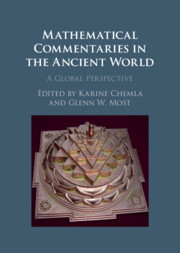Book contents
- Mathematical Commentaries in the Ancient World
- Mathematical Commentaries in the Ancient World
- Copyright page
- Contents
- Figures
- Tables
- Contributors
- Introduction
- Commentators at Work
- 2 Philosophical Commentaries on Mathematical Texts
- 3 Characterizing a Sanskrit Mathematical Commentary
- 4 Calling out Zheng Xuan (127–200 CE) at the Crossroads of Ritual, Mathematics, Sport, and Classical Commentary
- Comparing Commentaries
- Index of Proper Names
- Index of Subjects
- Index of Titles of Cited Texts
- References
4 - Calling out Zheng Xuan (127–200 CE) at the Crossroads of Ritual, Mathematics, Sport, and Classical Commentary
from Commentators at Work
Published online by Cambridge University Press: 02 June 2022
- Mathematical Commentaries in the Ancient World
- Mathematical Commentaries in the Ancient World
- Copyright page
- Contents
- Figures
- Tables
- Contributors
- Introduction
- Commentators at Work
- 2 Philosophical Commentaries on Mathematical Texts
- 3 Characterizing a Sanskrit Mathematical Commentary
- 4 Calling out Zheng Xuan (127–200 CE) at the Crossroads of Ritual, Mathematics, Sport, and Classical Commentary
- Comparing Commentaries
- Index of Proper Names
- Index of Subjects
- Index of Titles of Cited Texts
- References
Summary
It is Zheng Xuan (127–200), more than any other commentator, to whom we owe our current understanding of the Confucian Classics – Zheng Xuan, his subcommentators, Kong Yingda (574–648), and Jia Gongyan (fl. 637), who canonised his readings in the early Tang (618–907). Zheng Xuan made mistakes, however, and this chapter offers a case in point: the calculation of physically impossible target geometries for the royal archery meet reputedly held in the Western Zhou (1045–771 BCE), the ‘Big Shoot’ (dashe). In transforming the ambiguous language of the Classics into an elaborate mathematics problem with definite quantities, Zheng Xuan neglects to account for the targets being in three dimensions, and his subcommentators supply mathematical proofs for numbers that are ‘flat wrong’. It is not as if they could not have known, I argue, as the Big Shoot was living practice in their respective days, and as Zheng and Kong were trained in mathematics. Faced with this curious dissonance between exegesis, experience, and mathematical training, I suggest that we might better understand the work of the exegete as reconstructing abstract, ideal forms which were necessarily divorced from their reality and for which mathematics suggested itself as the perfect tool.
Keywords
- Type
- Chapter
- Information
- Mathematical Commentaries in the Ancient WorldA Global Perspective, pp. 141 - 196Publisher: Cambridge University PressPrint publication year: 2022

